Urban Outfitters Bundle
How Does Urban Outfitters Stay Ahead in the Ever-Changing Retail Game?
Urban Outfitters, a brand synonymous with trendsetting fashion and lifestyle products, has consistently adapted its sales and marketing strategies to thrive in the competitive retail market. From its humble beginnings near a university campus to its current status as a multi-brand powerhouse, the company's evolution offers valuable insights. This exploration examines the core elements of Urban Outfitters' approach, revealing the secrets behind its enduring appeal and customer acquisition.
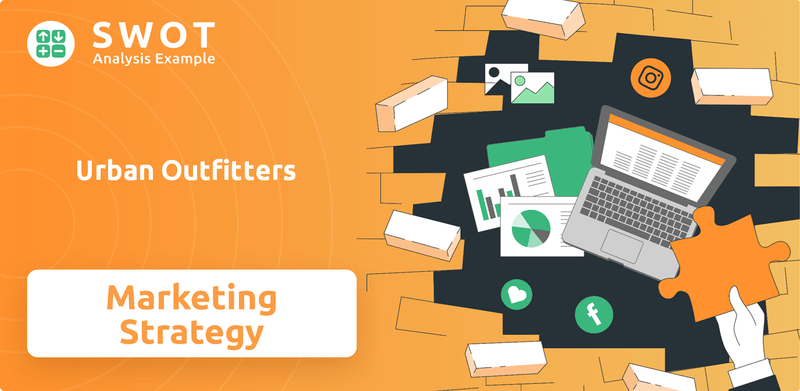
Understanding the Urban Outfitters SWOT Analysis is key to grasping their success. This article will dissect Urban Outfitters' sales strategy, focusing on its innovative marketing strategy and how it resonates with its target market. We'll explore their brand positioning, examine successful marketing campaign examples, and analyze the company's digital marketing performance, including its e-commerce sales strategy and omnichannel retail strategy, to understand how they maintain relevance and drive growth in a dynamic market.
How Does Urban Outfitters Reach Its Customers?
The sales strategy of Urban Outfitters centers on a multi-channel approach designed to engage its target market across various touchpoints. This strategy includes a blend of physical retail locations, a robust e-commerce presence, and wholesale partnerships. The company's marketing strategy is tailored to enhance brand positioning and drive customer acquisition through both online and offline channels, creating a cohesive brand experience.
Urban Outfitters' business model is built on a direct-to-consumer (DTC) strategy, with a strong emphasis on its e-commerce platform, which accounts for approximately 50% of its sales. This DTC focus allows for direct engagement with customers and data collection, informing future marketing campaigns and product development. The company's brand storytelling techniques and visual merchandising strategy are key to its success.
As of January 2025, the company operated 742 stores across its brands, including 262 Urban Outfitters stores in the United States, Canada, and Europe. The company has adapted to changing consumer behavior, with digital channel sales experiencing high single-digit positive growth for the three months ended January 31, 2025. This omnichannel retail strategy ensures that customers can interact with the brand in ways that suit their preferences, whether in-store or online. To understand the foundation of the company, you can read a Brief History of Urban Outfitters.
Urban Outfitters maintains a significant physical retail presence while investing heavily in its e-commerce platform. During the eleven months ended December 31, 2024, the company closed 12 retail locations but opened 45 new ones across its portfolio. The e-commerce platform continues to grow, with digital channel sales showing strong performance.
Wholesale partnerships and the DTC model are crucial. Free People wholesale sales increased by 20.3% in the third quarter of fiscal year 2025. The DTC segment, encompassing sales through the official website and mobile app, provides valuable customer data.
The Nuuly clothing rental service is a significant growth driver. It experienced a 56% sales jump in the fourth quarter ending January 31, 2025, and added 20,000 active subscription members, totaling 300,000. Nuuly's revenue target is $500 million by the end of 2025.
Urban Outfitters' marketing campaign examples include a focus on social media marketing strategy and influencer marketing to reach and engage its target market. The company also utilizes a customer loyalty program to encourage repeat purchases.
Urban Outfitters focuses on a multi-channel approach, integrating physical retail, e-commerce, and wholesale. This strategy aims to enhance customer engagement and drive sales through various touchpoints. The company's digital marketing performance is closely monitored to optimize its e-commerce sales strategy and email marketing best practices.
- Omnichannel Integration: Seamlessly blending online and offline experiences.
- DTC Focus: Leveraging direct-to-consumer channels for data and customer insights.
- Wholesale Partnerships: Expanding reach through distribution agreements.
- Subscription Services: Driving growth through innovative offerings like Nuuly.
Urban Outfitters SWOT Analysis
- Complete SWOT Breakdown
- Fully Customizable
- Editable in Excel & Word
- Professional Formatting
- Investor-Ready Format
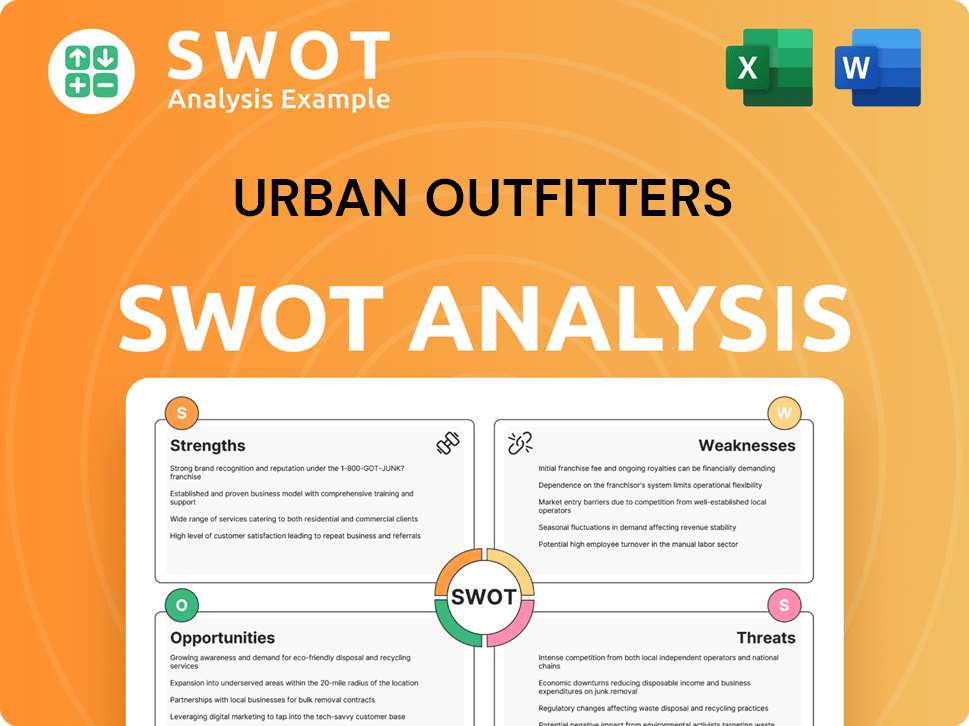
What Marketing Tactics Does Urban Outfitters Use?
The company's marketing tactics center on a multi-channel approach, blending digital and traditional methods to boost awareness, generate leads, and drive sales. Digital strategies are at the core of their efforts, using content marketing, paid advertising, email marketing, influencer partnerships, and a strong presence on social media platforms. This comprehensive approach is key to understanding the Urban Outfitters marketing strategy.
Central to their digital marketing are platforms like Instagram and TikTok, where they engage followers with visually appealing content that reflects their trendy, casual, and fun brand identity. They also leverage Pinterest to target millennials, sharing ideas for wardrobes and home decorating. This focus demonstrates how the company effectively reaches its Urban Outfitters target market.
Data-driven marketing, customer segmentation, and personalization are also important. They use analytics tools to track and optimize content performance and understand audience preferences. They design effective Facebook and Instagram ads that resonate with Millennials and Gen Z. The company also builds community, providing online spaces for customers to share stories and experiences, and actively seeks customer feedback, which contributes to their overall Urban Outfitters brand positioning.
Digital marketing is a cornerstone of the company’s strategy, with a strong emphasis on social media and content creation. They use platforms like Instagram and TikTok to captivate their audience. This approach is a key element of their Urban Outfitters customer acquisition strategy.
The company has seen significant growth in social media engagement. They experienced a +5,690% increase in net new followers on Instagram. Engagement on TikTok also rose significantly, with a +183% increase in Likes, +170% in Comments, and +102% in Shares.
Data analytics play a crucial role in refining their marketing efforts. They use tools to track content performance and understand audience preferences. This data-driven approach helps them optimize their campaigns.
The company focuses on building a community around its brand. They provide online spaces for customers to share experiences and actively seek customer feedback. This fosters a sense of belonging and loyalty.
They have a loyalty program to encourage repeat purchases and build customer loyalty. A significant percentage of millennials enroll in multiple loyalty programs. This is a key component of their Urban Outfitters customer loyalty program.
Recent initiatives include the UO100 college ambassador program launched in July 2024. They are also exploring experiential retail concepts like 'On Rotation' to enhance customer engagement.
The company uses a variety of tactics to engage its target audience and drive sales. These tactics are part of their overall Urban Outfitters sales strategy.
- Influencer Marketing: The UO100 program, launched in July 2024, uses college ambassadors to promote the brand on TikTok and Instagram. This is a prime example of how Urban Outfitters uses influencer marketing.
- Social Media: They actively use Instagram and TikTok to showcase visually curated content.
- Content Marketing: They share wardrobe and home decorating ideas on Pinterest.
- Data Analytics: They use tools like Dash Hudson to track and optimize content performance.
- Community Building: They provide online spaces for customers to share experiences and gather feedback.
- Experiential Retail: The 'On Rotation' concept focuses on user-generated content and engagement.
Urban Outfitters PESTLE Analysis
- Covers All 6 PESTLE Categories
- No Research Needed – Save Hours of Work
- Built by Experts, Trusted by Consultants
- Instant Download, Ready to Use
- 100% Editable, Fully Customizable
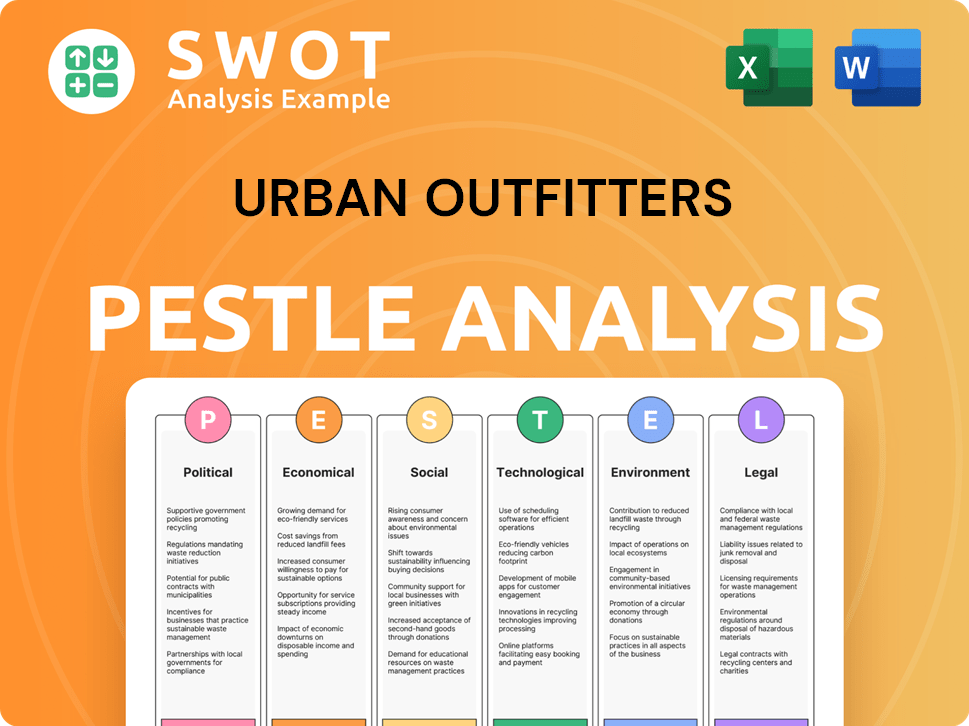
How Is Urban Outfitters Positioned in the Market?
The brand positioning of Urban Outfitters centers on appealing to a youthful demographic, primarily millennials and Generation Z, aged between 18 and 28. The company's strategy emphasizes individuality, creativity, and self-expression, offering unique and unconventional styles. This is achieved through a diverse product range, including apparel, accessories, home goods, and lifestyle items, often described as bohemian chic with a blend of vintage and modern influences. Its success is evident in its sales and revenue growth, driven by a commitment to personalization and customer engagement.
The visual identity and tone of voice are designed to be authentic and relatable to its target audience. This includes the use of emojis, trending slang, and a 'hippie aesthetic' in its social media presence. The in-store experience is also a key aspect of its brand positioning, with physical stores designed to provide a unique shopping experience, often featuring art installations and creative displays. The company aims to foster a sense of community among its customers through social media engagement, events, and collaborations.
Urban Outfitters' approach to brand positioning involves a consistent effort across all channels and touchpoints. This includes continuously refreshing its merchandise and incorporating emerging trends to create a sense of discovery and exclusivity. The company's commitment to personalization and customer engagement has contributed to its success, leading to significant growth in sales and revenue. For a deeper understanding of how the company has grown, check out the Growth Strategy of Urban Outfitters.
The primary target market consists of young adults, specifically millennials and Gen Z. The brand focuses on individuals aged 18 to 28, who are fashion-forward and value self-expression. This demographic is targeted through a variety of marketing efforts, including social media campaigns and in-store experiences.
The brand's identity is built around individuality, creativity, and self-expression. The visual identity includes a bohemian chic aesthetic with vintage and modern influences. This is reinforced through unique in-store experiences and consistent messaging across all channels.
The marketing strategy involves a mix of digital and in-store experiences to engage the target audience. This includes social media marketing, influencer collaborations, and creating unique shopping environments. The company also focuses on email marketing and content marketing to stay connected with its customers.
Customer acquisition is achieved through a combination of online and offline strategies. The company uses social media, email marketing, and in-store events to attract new customers. The focus is on creating a sense of community and offering exclusive products to drive customer engagement.
Urban Outfitters Business Model Canvas
- Complete 9-Block Business Model Canvas
- Effortlessly Communicate Your Business Strategy
- Investor-Ready BMC Format
- 100% Editable and Customizable
- Clear and Structured Layout
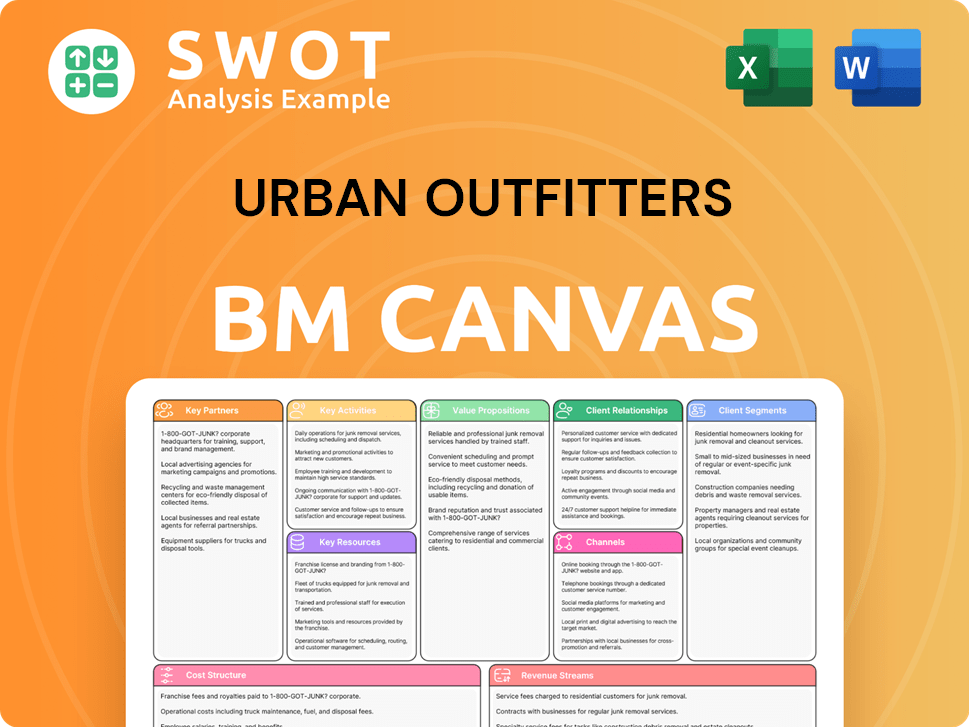
What Are Urban Outfitters’s Most Notable Campaigns?
The success of the company's Urban Outfitters sales strategy and Urban Outfitters marketing strategy hinges on impactful campaigns designed to resonate with its target demographic. These campaigns are carefully crafted to build brand loyalty and drive sales. The company consistently leverages social media and influencer partnerships to boost engagement and brand awareness.
A key component of the company's approach is the ability to adapt its content strategy to platform-specific trends. This is evident in their use of humor and cultural relevance in campaigns like 'Happy LOLidays' in late 2024, which was tailored for Gen Z and young millennials. This focus on engagement and community building is a significant part of their Urban Outfitters business model.
The company's marketing efforts are data-driven, with a strong emphasis on key performance indicators (KPIs) like user-generated content and engagement metrics. This approach allows for continuous refinement and optimization of campaigns, ensuring they remain effective in a competitive market. For a deeper understanding, check out the Target Market of Urban Outfitters.
Launched in late 2024, this campaign focused on humor and relatability. It featured gift guides and TikTok challenges, fostering a sense of community. The primary goal was to connect with Gen Z and young millennials.
Introduced in 2025, this campaign features collaborations with brands like Nike. The main KPI is user-generated content and engagement. It aims to excite customers and encourage social media posts.
Launched in July 2024, this program utilizes college influencers across the U.S. to promote the brand. It aims to deepen connections with the college demographic. The program generates authentic content.
In June 2025, the company is tapping 20-25 influencers for Nike's After Dark Race. This highlights the company's focus on experiential retail. It encourages content creation around the event.
These campaigns have led to significant growth in engagement metrics.
- Instagram: Follower growth of +5,690%.
- TikTok: Significant increases in likes, comments, and shares.
- Customer Acquisition: Effective strategies to bring in new customers.
- Brand Positioning: Strengthening their position in the market.
Urban Outfitters Porter's Five Forces Analysis
- Covers All 5 Competitive Forces in Detail
- Structured for Consultants, Students, and Founders
- 100% Editable in Microsoft Word & Excel
- Instant Digital Download – Use Immediately
- Compatible with Mac & PC – Fully Unlocked
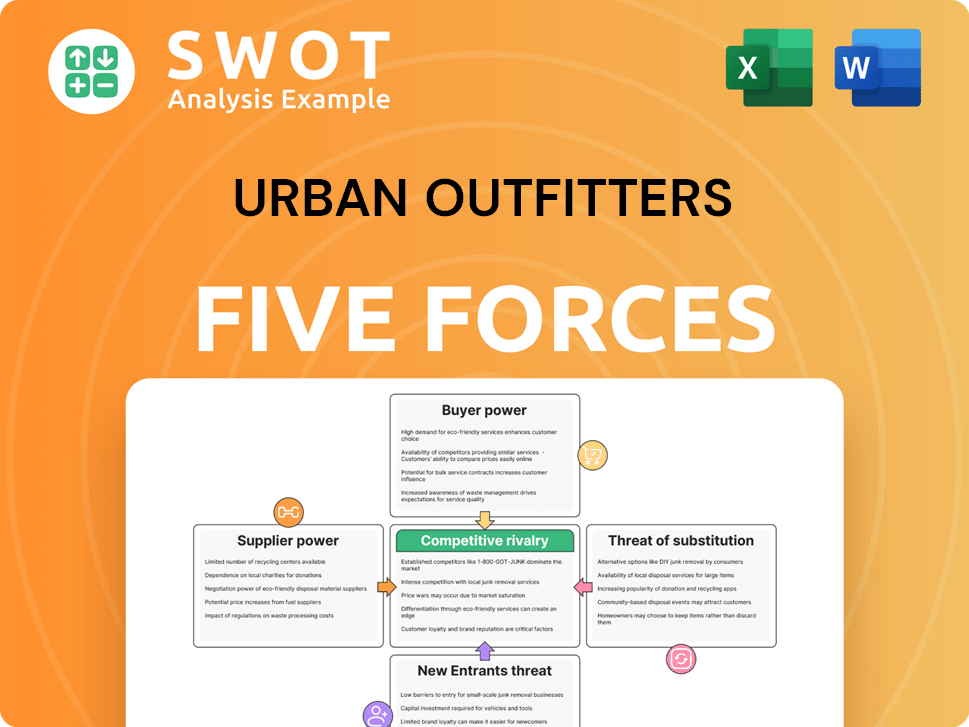
Related Blogs
- What are Mission Vision & Core Values of Urban Outfitters Company?
- What is Competitive Landscape of Urban Outfitters Company?
- What is Growth Strategy and Future Prospects of Urban Outfitters Company?
- How Does Urban Outfitters Company Work?
- What is Brief History of Urban Outfitters Company?
- Who Owns Urban Outfitters Company?
- What is Customer Demographics and Target Market of Urban Outfitters Company?
Disclaimer
All information, articles, and product details provided on this website are for general informational and educational purposes only. We do not claim any ownership over, nor do we intend to infringe upon, any trademarks, copyrights, logos, brand names, or other intellectual property mentioned or depicted on this site. Such intellectual property remains the property of its respective owners, and any references here are made solely for identification or informational purposes, without implying any affiliation, endorsement, or partnership.
We make no representations or warranties, express or implied, regarding the accuracy, completeness, or suitability of any content or products presented. Nothing on this website should be construed as legal, tax, investment, financial, medical, or other professional advice. In addition, no part of this site—including articles or product references—constitutes a solicitation, recommendation, endorsement, advertisement, or offer to buy or sell any securities, franchises, or other financial instruments, particularly in jurisdictions where such activity would be unlawful.
All content is of a general nature and may not address the specific circumstances of any individual or entity. It is not a substitute for professional advice or services. Any actions you take based on the information provided here are strictly at your own risk. You accept full responsibility for any decisions or outcomes arising from your use of this website and agree to release us from any liability in connection with your use of, or reliance upon, the content or products found herein.